Difference between revisions of "Template Only Features for Version 7.0 (OnePager Express)"
(→Task Links Tab) |
|||
| Line 1: | Line 1: | ||
==About Template Only Features== | ==About Template Only Features== | ||
| − | 1) Because the '''Template Properties''' and | + | 1) Because the '''Template Properties''' and '''Chart Properties''' forms are similar, this section only covers the areas of the former that are different from the latter. |
| − | 2) If you are unclear on the differences between a '''Template''' and a ''' | + | 2) If you are unclear on the differences between a '''Template''' and a '''Chart Properties''', please review the explanation in the [[Core Concepts for OnePager 6.1 (Portal) | Core Concepts (Portal)]] 4.0.1-70 and [[Templates versus Charts for Version 6.1 | Templates versus Charts]] 4.3.1-70 articles. |
| − | 3) You should familiarize yourself with ''' | + | 3) You should familiarize yourself with '''Chart Properties''' form before reading this section. |
4) Please see the article at this link: [[Editing with the Chart Properties form for Version 7.0 (Portal) | Editing with the Chart Properties form (Portal)]] 21.0.1-70 for more information and access to more detailed articles. | 4) Please see the article at this link: [[Editing with the Chart Properties form for Version 7.0 (Portal) | Editing with the Chart Properties form (Portal)]] 21.0.1-70 for more information and access to more detailed articles. | ||
| Line 17: | Line 17: | ||
:b) The '''permanent template''' cannot be modified hence all the control features on each tab are disabled (ghosted). | :b) The '''permanent template''' cannot be modified hence all the control features on each tab are disabled (ghosted). | ||
| − | 2) '''Metric versus Non-Metric'''. Within a '''Template''' there are settings which are measures that must be considered when building the | + | 2) '''Metric versus Non-Metric'''. Within a '''Template''' there are settings which are measures that must be considered when building the chart. |
:a) These include the '''height''' of individual rows, the '''height''' of the percent-complete bar within a task bar, and the like. | :a) These include the '''height''' of individual rows, the '''height''' of the percent-complete bar within a task bar, and the like. | ||
| Line 27: | Line 27: | ||
4) Ideally, you can use one of the '''Templates''' provided one time and then from there you can customize your project using your own customer '''Template'''. | 4) Ideally, you can use one of the '''Templates''' provided one time and then from there you can customize your project using your own customer '''Template'''. | ||
| − | :a) Once a | + | :a) Once a chart is customized it may be transformed into a '''Template''' using the '''Copy to Template''' button on the ribbon's '''Home''' tab. |
:b) Our '''Templates''' give you a starting point, but to maximize your efficiency, we recommend you learn how to create and update your own '''Templates'''. | :b) Our '''Templates''' give you a starting point, but to maximize your efficiency, we recommend you learn how to create and update your own '''Templates'''. | ||
| Line 33: | Line 33: | ||
==Main Template Tab== | ==Main Template Tab== | ||
| − | 1) The '''Main''' tab of the '''Template Properties''' form differs slightly from the ''' | + | 1) The '''Main''' tab of the '''Template Properties''' form differs slightly from the '''Chart Properties''' form. The '''Template''' does not have entry controls for the '''Start date''', '''End date''', '''Title''', because '''dates''' are systematically produced by OnePager based on the earliest '''start date''' and '''latest finish dates''' in your '''source plan''' data. The '''Title''' is something you designate as you create the new chart with the OnePager choices ('''OPC''') form. |
<center>[[File:X61-24_1_1-61-(1)-08302018.png]]</center> | <center>[[File:X61-24_1_1-61-(1)-08302018.png]]</center> | ||
| Line 47: | Line 47: | ||
==Time Axis Tab== | ==Time Axis Tab== | ||
| − | 1) The '''Time Axis''' tab is new to OnePager Express 6.1. The intent is to provide additional '''Time Axis creation''' and '''editing''' capabilities and to centralize all '''time axis''' related controls at one '''Template''' form tab. The same intent is true for the ''' | + | 1) The '''Time Axis''' tab is new to OnePager Express 6.1. The intent is to provide additional '''Time Axis creation''' and '''editing''' capabilities and to centralize all '''time axis''' related controls at one '''Template''' form tab. The same intent is true for the '''Chart Properties''' form's '''Time Axis''' tab. |
2) The new '''Time Axis''' tab for the OnePager Express 6.1 '''Template''' form is shown below: | 2) The new '''Time Axis''' tab for the OnePager Express 6.1 '''Template''' form is shown below: | ||
| Line 54: | Line 54: | ||
<center><X61-24_1_1-61-(4)-08302018.png></center> | <center><X61-24_1_1-61-(4)-08302018.png></center> | ||
| − | 3) The controls in the '''Time Axis''' tab are identical to those in the ''' | + | 3) The controls in the '''Time Axis''' tab are identical to those in the '''Chart Properties''' form's '''Time Axis''' tab with the exceptions noted above. |
4) For more information on the use of the controls in the '''Time Axis''' tab please see the article at: [[Modifying the Time Axis for Version 6.1 (Portal) | Modifying the Time Axis (Portal)]]. 22.0.1-70 | 4) For more information on the use of the controls in the '''Time Axis''' tab please see the article at: [[Modifying the Time Axis for Version 6.1 (Portal) | Modifying the Time Axis (Portal)]]. 22.0.1-70 | ||
| Line 60: | Line 60: | ||
==Task Links Tab== | ==Task Links Tab== | ||
| − | 1) The '''Task Links''' tab is new in OnePager Express 6.1. Its purpose is to provide the capability to preset properties for '''data-driven''' and manual '''Task Links''' before a | + | 1) The '''Task Links''' tab is new in OnePager Express 6.1. Its purpose is to provide the capability to preset properties for '''data-driven''' and manual '''Task Links''' before a chart is created. |
<center>[[File:X61-24_1_1-61-(3)-08302018.png]]</center> | <center>[[File:X61-24_1_1-61-(3)-08302018.png]]</center> | ||
| Line 67: | Line 67: | ||
2) Of importance is the '''Show task links''' checkbox in the '''Default Task-Link Formatting''' control group shown above. This checkbox acts as a '''Master Switch''' enabling the '''Task Links''' feature in OnePager Express. | 2) Of importance is the '''Show task links''' checkbox in the '''Default Task-Link Formatting''' control group shown above. This checkbox acts as a '''Master Switch''' enabling the '''Task Links''' feature in OnePager Express. | ||
| − | 3) The '''Import predecessors''' checkbox is unchecked or '''OFF''' in OnePager Express distributed '''Templates'''. This avoids an initial cluttering of the | + | 3) The '''Import predecessors''' checkbox is unchecked or '''OFF''' in OnePager Express distributed '''Templates'''. This avoids an initial cluttering of the chart if there are a large number of '''dependencies imported''' from the Microsoft Project '''source plan'''. This approach also gives you full control over the '''Task Link import''' process from the chart. |
| − | 4) The controls in the '''Task Links''' tab are identical to those in the ''' | + | 4) The controls in the '''Task Links''' tab are identical to those in the '''Chart Properties''' form's '''Task Links''' tab with the exceptions noted above. |
| − | 5) For more information on using the ''' | + | 5) For more information on using the '''Chart Properties''' form's '''Task Links''' tab, please see this article at: [[Editing Task Links with the Chart Properties Form for OnePager Express for Version 7.0 | Editing Task Links with the Chart Properties Form for OnePager Express]]. 19.3.2-70 |
==Advanced Template Tab== | ==Advanced Template Tab== | ||
| − | 1) The '''Advanced''' tab is shown below. Most of these parameters in the '''Template''' are identical to those appearing in the ''' | + | 1) The '''Advanced''' tab is shown below. Most of these parameters in the '''Template''' are identical to those appearing in the '''Chart Properties''' form. |
<center>[[File:X61-24_2_1-61-(8-1)-11262018.png]]</center> | <center>[[File:X61-24_2_1-61-(8-1)-11262018.png]]</center> | ||
<center><X61-24_2_1-61-(8-1)-11262018.png></center> | <center><X61-24_2_1-61-(8-1)-11262018.png></center> | ||
| − | :a) In the '''Template’s Advanced''' tab there is no '''Lock background''' checkbox in the '''Display options''' group. This is an option available after the | + | :a) In the '''Template’s Advanced''' tab there is no '''Lock background''' checkbox in the '''Display options''' group. This is an option available after the chart is created. |
| − | :b) One key difference between the '''Template Properties''' form and ''' | + | :b) One key difference between the '''Template Properties''' form and '''Chart Properties''' form is the ability to use the '''Template''' to configure a '''multi-project''' import The next sub-section explains this further. |
| − | :c) For more information on creating '''multi-project''' | + | :c) For more information on creating '''multi-project''' charts please visit these two articles: |
<center> | <center> | ||
| Line 96: | Line 96: | ||
===Merge Tasks On Snapshot Replacement (see screenshot above)=== | ===Merge Tasks On Snapshot Replacement (see screenshot above)=== | ||
| − | 2) Checking this checkbox puts any | + | 2) Checking this checkbox puts any charts created with this '''Template''' into the '''multi-file multi-project mode'''. |
| − | 3) This mode is specifically designed to support users who want to create '''multi-project''' | + | 3) This mode is specifically designed to support users who want to create '''multi-project''' charts from several independent Microsoft Excel '''source plans'''. It allows OnePager to recognize data as coming from more than one unique file and combine that into your OnePager chart, hence the '''merge''' reference. |
4) This is an advanced feature and when used, OnePager needs you to create a '''Task ID''' column with uniquely numbered tasks and milestones that can be imported from the various Microsoft Excel '''source plans'''. | 4) This is an advanced feature and when used, OnePager needs you to create a '''Task ID''' column with uniquely numbered tasks and milestones that can be imported from the various Microsoft Excel '''source plans'''. | ||
| Line 107: | Line 107: | ||
::i) Suppose that the first Microsoft Excel '''source plan''' contains tasks A, B, and C and that the second '''source plan''' contains tasks D, E, and F. | ::i) Suppose that the first Microsoft Excel '''source plan''' contains tasks A, B, and C and that the second '''source plan''' contains tasks D, E, and F. | ||
| − | ::ii) After making a new | + | ::ii) After making a new chart from the first '''source plan''', you open the second Microsoft Excel '''source plan''' and '''update''' the chart in '''Replace Snapshot''' mode. |
| − | ::iii) If the checkbox is checked, the | + | ::iii) If the checkbox is checked, the chart now contains tasks A, B, C, D, E, and F. |
| − | ::iv) If the checkbox is not checked, the | + | ::iv) If the checkbox is not checked, the chart now contains only tasks D, E, and F. |
| − | :b) Once you adopted this scheme for the | + | :b) Once you adopted this scheme for the chart being created, it is not possible to update the chart in the future in the default single-file single-project mode. |
==Field Mappings Template Tab== | ==Field Mappings Template Tab== | ||
| Line 124: | Line 124: | ||
1) OnePager uses '''source fields''' for many purposes : displaying task names, displaying start dates, assigning colors to tasks, and grouping rows into swimlanes. We call the use of a '''source field''' for a purpose a '''field mapping'''. The eight dropdown lists above are a set of important '''field mappings''' that are collected in one form tab page. The other '''field mappings''' are on the Rows/Swimlanes, Task Bars, and Milestones form tab pages. Some '''field mappings''' (e.g. percent-complete) appear both here and on other form tab pages. | 1) OnePager uses '''source fields''' for many purposes : displaying task names, displaying start dates, assigning colors to tasks, and grouping rows into swimlanes. We call the use of a '''source field''' for a purpose a '''field mapping'''. The eight dropdown lists above are a set of important '''field mappings''' that are collected in one form tab page. The other '''field mappings''' are on the Rows/Swimlanes, Task Bars, and Milestones form tab pages. Some '''field mappings''' (e.g. percent-complete) appear both here and on other form tab pages. | ||
| − | 2) This new '''Field Mappings''' tab in the '''Template''' is also available in the ''' | + | 2) This new '''Field Mappings''' tab in the '''Template''' is also available in the '''Chart Properties''' form. |
3) Each dropdown list contains the '''source fields''' that have the correct data type(s) for the purpose. For example, in the '''Basic Mappings''' group, the '''Task label''' field dropdown contains only text fields from Microsoft Project. And the dropdown lists in the '''Date Mappings''' group contain only Microsoft Exce; date fields. | 3) Each dropdown list contains the '''source fields''' that have the correct data type(s) for the purpose. For example, in the '''Basic Mappings''' group, the '''Task label''' field dropdown contains only text fields from Microsoft Project. And the dropdown lists in the '''Date Mappings''' group contain only Microsoft Exce; date fields. | ||
| Line 139: | Line 139: | ||
6)The '''Task/Milestone Identity Mapping''' group lets you select a Microsoft Excel field that can be used to uniquely identifies each task. | 6)The '''Task/Milestone Identity Mapping''' group lets you select a Microsoft Excel field that can be used to uniquely identifies each task. | ||
| − | 7) Uniquely identifying each task or milestone is always important when you plan to update your | + | 7) Uniquely identifying each task or milestone is always important when you plan to update your chart later on, but you normally do not need to change this '''field mapping''' because the default mapping works just fine. |
| − | :a) OnePager uses the '''Unique Id''' field to identify each task in the '''source plan''', enabling preservation of each task’s color, labeling, and vertical location as you import new or modified data in later updates of the | + | :a) OnePager uses the '''Unique Id''' field to identify each task in the '''source plan''', enabling preservation of each task’s color, labeling, and vertical location as you import new or modified data in later updates of the chart. |
:b) For '''source plans''' that are Microsoft Excel files, the default mapping is to the Microsoft Excel '''Task ID''' field. | :b) For '''source plans''' that are Microsoft Excel files, the default mapping is to the Microsoft Excel '''Task ID''' field. | ||
| − | :c) If you opt to change the '''Task ID''' mapping away from these reliable defaults, make sure that the new '''source''' field has a unique value for each task or milestone. Bear in mind that once you create a | + | :c) If you opt to change the '''Task ID''' mapping away from these reliable defaults, make sure that the new '''source''' field has a unique value for each task or milestone. Bear in mind that once you create a chart with a '''Task ID''' mapping, it is nearly impossible to change your mind about how tasks are to be identified. Change this mapping away from the default only if you have a good reason to do so and are sure that the field contains no duplicate values. |
8) To map an alternate '''Task ID''' field, use the dropdown menu shown in the illustration below: | 8) To map an alternate '''Task ID''' field, use the dropdown menu shown in the illustration below: | ||
| Line 161: | Line 161: | ||
===Field Splitting Feature=== | ===Field Splitting Feature=== | ||
| − | 11) The '''Field Splitting''' group lets you split each task into a set of nearly-duplicate tasks based upon a comma-separated list of values in some '''source''' field. For example, you could split a task that had three '''Resources''' assigned to it into three almost-identical tasks that differ only in their value of '''Resource'''. Once you create a | + | 11) The '''Field Splitting''' group lets you split each task into a set of nearly-duplicate tasks based upon a comma-separated list of values in some '''source''' field. For example, you could split a task that had three '''Resources''' assigned to it into three almost-identical tasks that differ only in their value of '''Resource'''. Once you create a chart with '''field splitting''' turned on, it is impossible to change your mind and go back to '''unsplit''' tasks for that chart or change to a different field for the splitting. |
12) See the article at: [[Splitting and Parsing Columns for OnePager Express for Version 6.1 | Splitting and Parsing Columns-OnePager Express]] 24.5.1-70 for more information. | 12) See the article at: [[Splitting and Parsing Columns for OnePager Express for Version 6.1 | Splitting and Parsing Columns-OnePager Express]] 24.5.1-70 for more information. | ||
Revision as of 21:34, 20 February 2019
Contents
About Template Only Features
1) Because the Template Properties and Chart Properties forms are similar, this section only covers the areas of the former that are different from the latter.
2) If you are unclear on the differences between a Template and a Chart Properties, please review the explanation in the Core Concepts (Portal) 4.0.1-70 and Templates versus Charts 4.3.1-70 articles.
3) You should familiarize yourself with Chart Properties form before reading this section.
4) Please see the article at this link: Editing with the Chart Properties form (Portal) 21.0.1-70 for more information and access to more detailed articles.
A Few Words On Templates
1) Permanent Template. Chronicle Graphics, Inc. ships OPX with one pre-defined permanent template that you cannot accidentally delete.
- a) The permanent template has the word Permanent in its name.
- b) The permanent template cannot be modified hence all the control features on each tab are disabled (ghosted).
2) Metric versus Non-Metric. Within a Template there are settings which are measures that must be considered when building the chart.
- a) These include the height of individual rows, the height of the percent-complete bar within a task bar, and the like.
- b) OnePager supports two measurement conventions: (1) English (inches) and (2) Metric (centimeters). For convenience you can identify a Metric based Template because the word (metric) is included in the title. And these two sets of Templates are separated by default into English and a Metric subfolder of the default templates folder.
3) In addition to the English and Metric folders in the Template folder there is a Legacy folder containing Templates from versions of OPP prior to version 5.3.
4) Ideally, you can use one of the Templates provided one time and then from there you can customize your project using your own customer Template.
- a) Once a chart is customized it may be transformed into a Template using the Copy to Template button on the ribbon's Home tab.
- b) Our Templates give you a starting point, but to maximize your efficiency, we recommend you learn how to create and update your own Templates.
Main Template Tab
1) The Main tab of the Template Properties form differs slightly from the Chart Properties form. The Template does not have entry controls for the Start date, End date, Title, because dates are systematically produced by OnePager based on the earliest start date and latest finish dates in your source plan data. The Title is something you designate as you create the new chart with the OnePager choices (OPC) form.
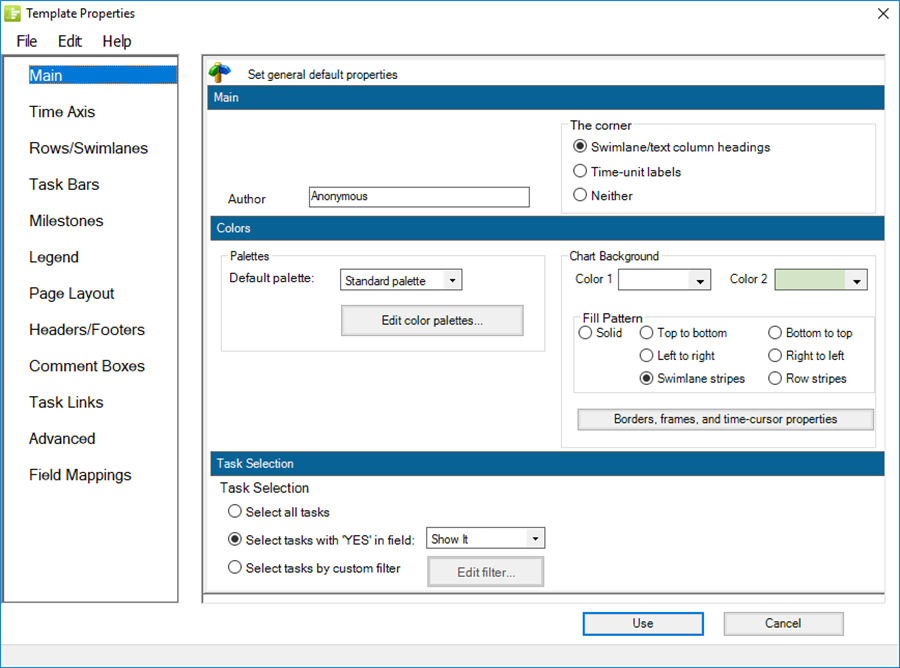
2) The Colors control group provides access to the Color Palette controls for creating and editing Color Palettes. Additionally, the Colors control group contains all the controls for setting the Chart Background and access to the Set line properties form and its sub-tabs through the Borders, frames, and time-cursor properties button shown here:
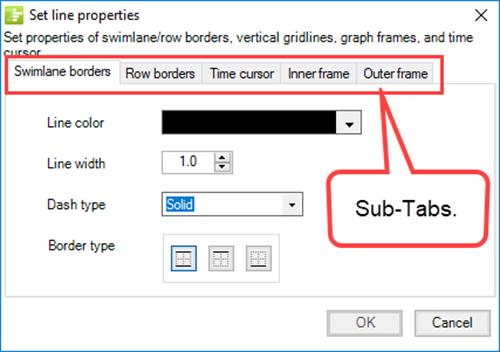
3) The Task Selection control group provides a convenient place in the Template for you to preset the method you want to use for importing task/milestone information from your Microsoft Project source plan.
Time Axis Tab
1) The Time Axis tab is new to OnePager Express 6.1. The intent is to provide additional Time Axis creation and editing capabilities and to centralize all time axis related controls at one Template form tab. The same intent is true for the Chart Properties form's Time Axis tab.
2) The new Time Axis tab for the OnePager Express 6.1 Template form is shown below:
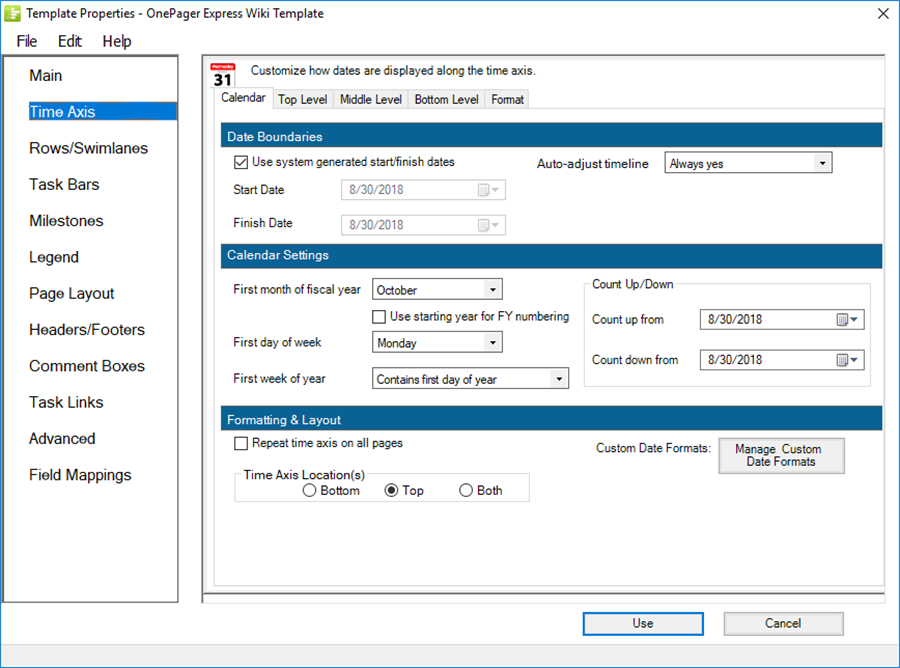
3) The controls in the Time Axis tab are identical to those in the Chart Properties form's Time Axis tab with the exceptions noted above.
4) For more information on the use of the controls in the Time Axis tab please see the article at: Modifying the Time Axis (Portal). 22.0.1-70
Task Links Tab
1) The Task Links tab is new in OnePager Express 6.1. Its purpose is to provide the capability to preset properties for data-driven and manual Task Links before a chart is created.
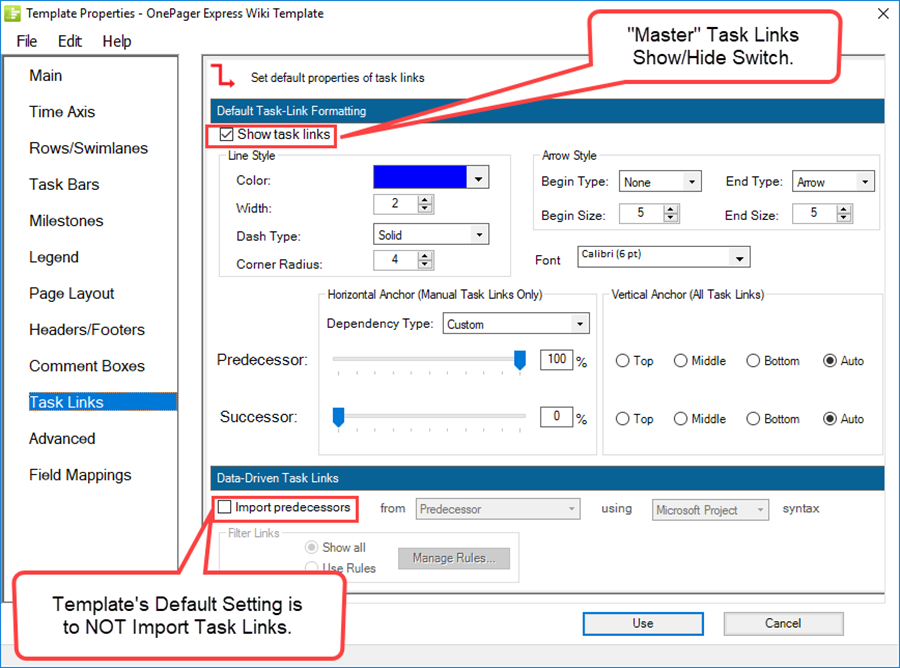
2) Of importance is the Show task links checkbox in the Default Task-Link Formatting control group shown above. This checkbox acts as a Master Switch enabling the Task Links feature in OnePager Express.
3) The Import predecessors checkbox is unchecked or OFF in OnePager Express distributed Templates. This avoids an initial cluttering of the chart if there are a large number of dependencies imported from the Microsoft Project source plan. This approach also gives you full control over the Task Link import process from the chart.
4) The controls in the Task Links tab are identical to those in the Chart Properties form's Task Links tab with the exceptions noted above.
5) For more information on using the Chart Properties form's Task Links tab, please see this article at: Editing Task Links with the Chart Properties Form for OnePager Express. 19.3.2-70
Advanced Template Tab
1) The Advanced tab is shown below. Most of these parameters in the Template are identical to those appearing in the Chart Properties form.
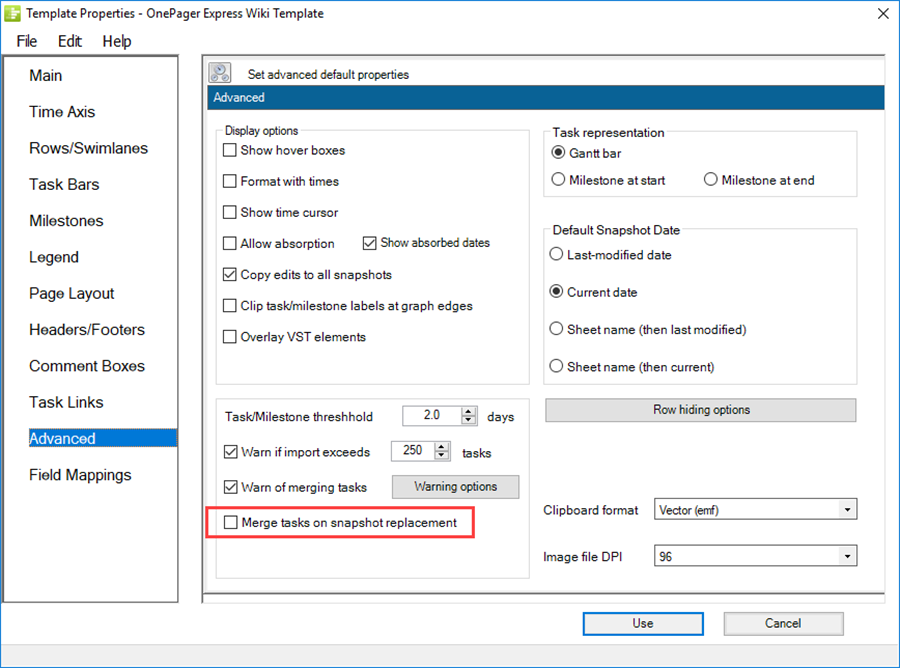
- a) In the Template’s Advanced tab there is no Lock background checkbox in the Display options group. This is an option available after the chart is created.
- b) One key difference between the Template Properties form and Chart Properties form is the ability to use the Template to configure a multi-project import The next sub-section explains this further.
- c) For more information on creating multi-project charts please visit these two articles:
| Basic Workflows (Portal) 7.0.1-70 |
| Creating Various Multi-Charts with OnePager Pro and Express (Portal) 8.0.1-70 |
Merge Tasks On Snapshot Replacement (see screenshot above)
2) Checking this checkbox puts any charts created with this Template into the multi-file multi-project mode.
3) This mode is specifically designed to support users who want to create multi-project charts from several independent Microsoft Excel source plans. It allows OnePager to recognize data as coming from more than one unique file and combine that into your OnePager chart, hence the merge reference.
4) This is an advanced feature and when used, OnePager needs you to create a Task ID column with uniquely numbered tasks and milestones that can be imported from the various Microsoft Excel source plans.
5) This is necessary so that OnePager uniquely recognize each row in each separate file.
- a) A simple example shows how this checkbox works.
- i) Suppose that the first Microsoft Excel source plan contains tasks A, B, and C and that the second source plan contains tasks D, E, and F.
- ii) After making a new chart from the first source plan, you open the second Microsoft Excel source plan and update the chart in Replace Snapshot mode.
- iii) If the checkbox is checked, the chart now contains tasks A, B, C, D, E, and F.
- iv) If the checkbox is not checked, the chart now contains only tasks D, E, and F.
- b) Once you adopted this scheme for the chart being created, it is not possible to update the chart in the future in the default single-file single-project mode.
Field Mappings Template Tab
6)The new Field Mappings tab in the Template form for OnePager Express looks like this:
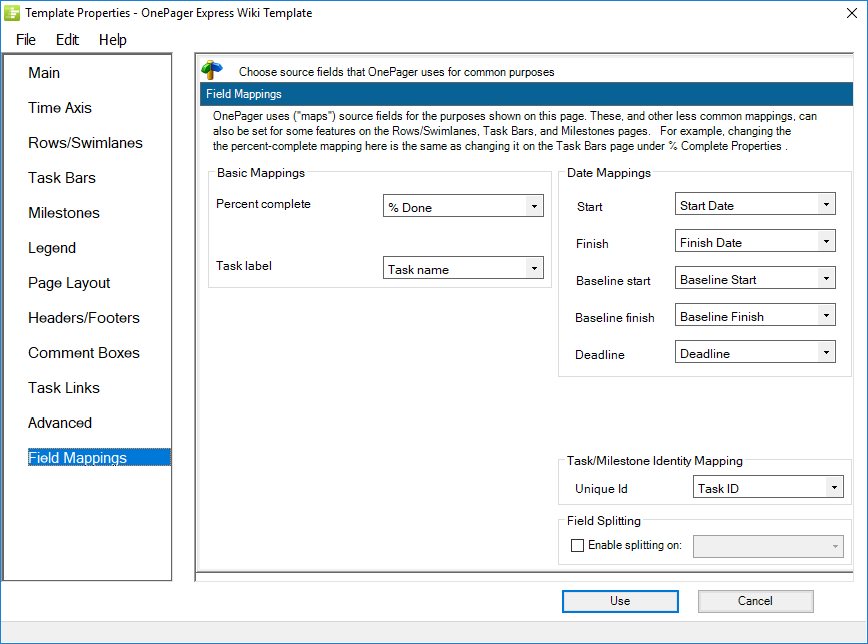
Basic and Date Mappings
1) OnePager uses source fields for many purposes : displaying task names, displaying start dates, assigning colors to tasks, and grouping rows into swimlanes. We call the use of a source field for a purpose a field mapping. The eight dropdown lists above are a set of important field mappings that are collected in one form tab page. The other field mappings are on the Rows/Swimlanes, Task Bars, and Milestones form tab pages. Some field mappings (e.g. percent-complete) appear both here and on other form tab pages.
2) This new Field Mappings tab in the Template is also available in the Chart Properties form.
3) Each dropdown list contains the source fields that have the correct data type(s) for the purpose. For example, in the Basic Mappings group, the Task label field dropdown contains only text fields from Microsoft Project. And the dropdown lists in the Date Mappings group contain only Microsoft Exce; date fields.
4) These mappings are useful if your standard field usage differs and you want to avoid having to constantly make the changes on the second page of OPC form shown below:
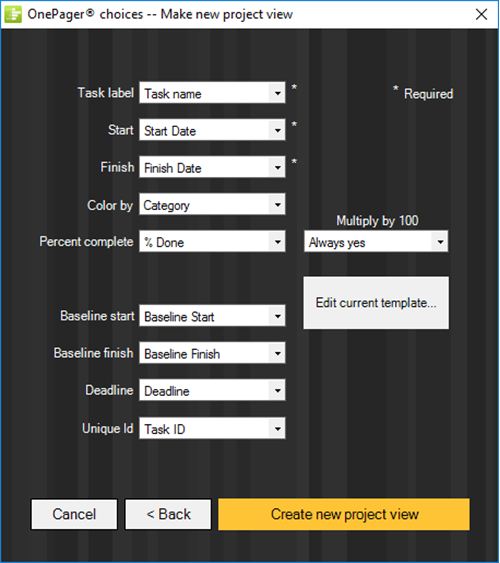
5) For more detailed information on the use of this feature please go to article with starting section link: Field Mappings Tab for OnePager Express - Basic Mappings. 21.16.1-70
Task/Milestone Identity Mapping
6)The Task/Milestone Identity Mapping group lets you select a Microsoft Excel field that can be used to uniquely identifies each task.
7) Uniquely identifying each task or milestone is always important when you plan to update your chart later on, but you normally do not need to change this field mapping because the default mapping works just fine.
- a) OnePager uses the Unique Id field to identify each task in the source plan, enabling preservation of each task’s color, labeling, and vertical location as you import new or modified data in later updates of the chart.
- b) For source plans that are Microsoft Excel files, the default mapping is to the Microsoft Excel Task ID field.
- c) If you opt to change the Task ID mapping away from these reliable defaults, make sure that the new source field has a unique value for each task or milestone. Bear in mind that once you create a chart with a Task ID mapping, it is nearly impossible to change your mind about how tasks are to be identified. Change this mapping away from the default only if you have a good reason to do so and are sure that the field contains no duplicate values.
8) To map an alternate Task ID field, use the dropdown menu shown in the illustration below:
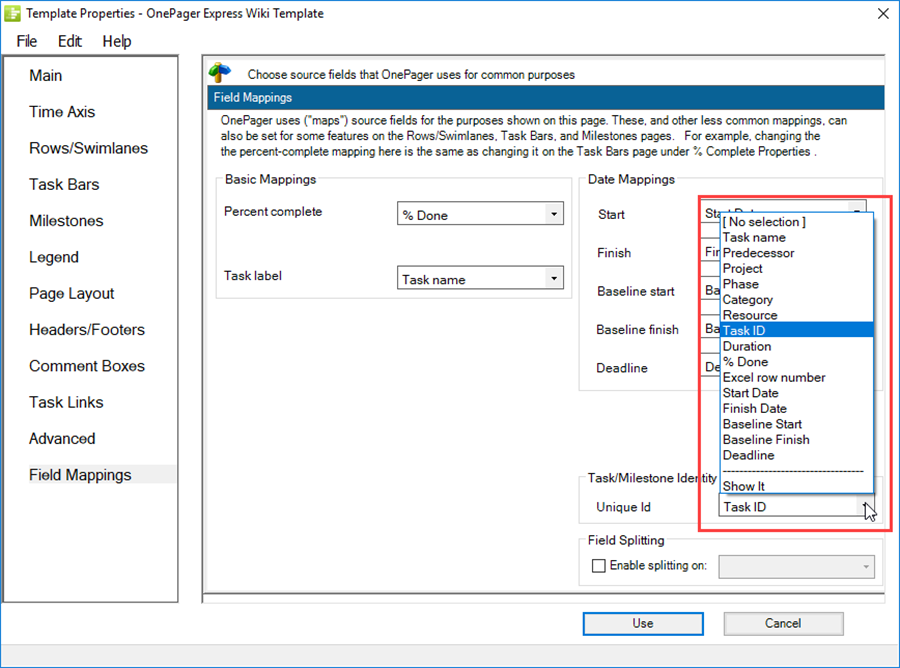
9) When changing to an alternate Unique Id field, OnePager displays a warning message as follows:
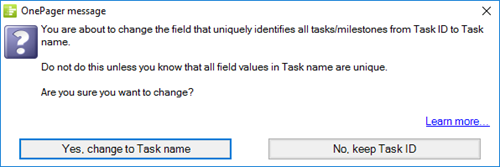
10) For more information on this feature, please go to this link: Field Mappings Tab for OnePager Express - Task/Milestone Identity Mapping. 21.16.1-70
Field Splitting Feature
11) The Field Splitting group lets you split each task into a set of nearly-duplicate tasks based upon a comma-separated list of values in some source field. For example, you could split a task that had three Resources assigned to it into three almost-identical tasks that differ only in their value of Resource. Once you create a chart with field splitting turned on, it is impossible to change your mind and go back to unsplit tasks for that chart or change to a different field for the splitting.
12) See the article at: Splitting and Parsing Columns-OnePager Express 24.5.1-70 for more information.
13) For more information on the Field Mappings Tab, see the article at this link: Field Mappings Tab for OnePager Express. 21.16.1-70
(24.2.1-70)